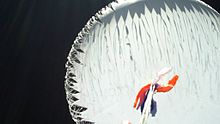
Back منطاد بحثي Arabic Стратастат Byelorussian Стратостат Bulgarian Globo estratosférico Spanish Baloi estratosferiko Basque بالون استراتوسفر Persian Ballon stratosphérique French Ստրատոստատ Armenian Balon altitudo tinggi ID 高高度気球 Japanese

High-altitude balloons or stratostats are usually uncrewed balloons typically filled with helium or hydrogen and released into the stratosphere, generally attaining between 18 and 37 km (11 and 23 mi; 59,000 and 121,000 ft) above sea level. In 2013, a balloon named BS 13-08 reached a record altitude of 53.7 km (33.4 mi; 176,000 ft).[1]
The most common type of high-altitude balloons are weather balloons. Other purposes include use as a platform for experiments in the upper atmosphere. Modern balloons generally contain electronic equipment such as radio transmitters, cameras, or satellite navigation systems, such as GPS receivers. Hobbyists frequently purchase weather balloons because of their ease of use, low price point, and widespread commoditisation.
These balloons are launched into what is defined as "near space", defined as the area of Earth's atmosphere between the Armstrong limit (18–19 km (11–12 mi) above sea level), where pressure falls to the point that a human being cannot survive without a pressurised suit, and the Kármán line (100 km (62 mi) above sea level[2]), where astrodynamics must take over from aerodynamics in order to maintain flight.
Due to the low cost of GPS and communications equipment, high-altitude ballooning is a popular hobby, with organizations such as UKHAS assisting the development of payloads.[3][4]



- ^ "ISAS | 超薄膜高高度気球(BS13-08)が無人気球到達高度の世界記録を更新 / トピックス" [Ultra-thin film high-altitude balloon (BS13-08) breaks the world record for altitude reached by an unmanned balloon]. Institute of Space and Astronautical Science, Japan Aerospace Exploration Agency (in Japanese). 2013-09-20. Archived from the original on 2023-03-06. Retrieved 2023-12-03.
- ^ Sanz Fernández de Córdoba, Dr. S. (2004-06-24). "The 100 km Boundary for Astronautics". Fédération aéronautique internationale. Retrieved 28 December 2020.
- ^ "DIY balloon sent up 30km". Boing Boing. 26 October 2007. Retrieved 2008-06-08.
- ^ McDermott, Vincent (8 August 2011). "Space race for DIYers". National Post. Archived from the original on 2013-02-28. Retrieved 2011-12-28.
© MMXXIII Rich X Search. We shall prevail. All rights reserved. Rich X Search